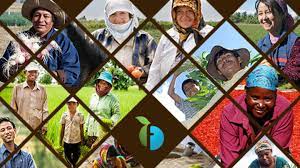
Over the last century, the global population has quadrupled. In 1915, there were 1.8 billion people in the world. Today, according to the most recent estimate by the UN, there are 7.3 billion people — and we may reach 9.7 billion by 2050. This growth, along with rising incomes in developing countries (which cause dietary changes such as eating more protein and meat) are driving up global food demand. Food demand is expected to increase anywhere between 59% to 98% by 2050. This will shape agricultural markets in ways we have not seen before. Farmers worldwide will need to increase crop production, either by increasing the amount of agricultural land to grow crops or by enhancing productivity on existing agricultural lands through fertilizer and irrigation and adopting new methods like precision farming. However, the ecological and social trade-offs of clearing more land for agriculture are often high, particularly in the tropics. And right now, crop yields — the amount of crops harvested per unit of land cultivated — are growing too slowly to meet the forecasted demand for food. Many other factors, from climate change to urbanization to a lack of investment, will also make it challenging to produce enough food. There is strong academic consensus that climate change–driven water scarcity, rising global temperatures, and extreme weather will have severe long-term effects on crop yields. These are expected to impact many major agricultural regions, especially those close to the Equator. For example, the Brazilian state of Mato Grosso, one of the most important agricultural regions worldwide, may face an 18% to 23% reduction in soy and corn output by 2050, due to climate change. The Midwestern U.S. and Eastern Australia — two other globally important regions — may also see a substantial decline in agricultural output due to extreme heat. Yet some places are expected to (initially) benefit from climate change. Countries stretching over northern latitudes — mainly China, Canada, and Russia — are forecasted to experience longer and warmer growing seasons in certain areas. Russia, which is already a major grain exporter, has huge untapped production potential because of large crop yield gaps (the difference between current and potential yields under current conditions) and widespread abandoned farmland (more than 40 million hectares, an area larger than Germany) following the dissolution of the Soviet Union, in 1991. The country arguably has the most agricultural opportunity in the world, but institutional reform and significant investments in agriculture and rural infrastructure will be needed to realize it. Advanced logistics, transportation, storage, and processing are also crucial for making sure that food goes from where it grows in abundance to where it doesn’t. This is where soft commodity trading companies, such as Cargill, Louis Dreyfus, or COFCO, come in. While Big Food companies such as General Mills or Unilever have tremendous global influence on what people eat, trading companies have a much greater impact on food security, because they source and distribute our staple foods and the ingredients used by Big Food, from rice, wheat, corn, and sugar to soybean and oil palm. They also store periodically produced grains and oilseeds so that they can be consumed all year, and they process soft commodities so that they can be used further down the value chain. For example, wheat needs to be milled into flour to produce bread or noodles, and soybeans must be crushed to produce oil or feed for livestock. First and foremost, farmers, trading companies, and other processing groups (Big Food in particular) need to commit to deforestation-free supply chains. Deforestation causes rapid and irreversible losses of biodiversity, is the second largest source of carbon dioxide emissions after fossil fuels, and has contributed greatly to global warming—adding to the negative pressure on agriculture production for which these forests were cleared in the first place. Farmers must also grow more on the land they currently operate through what is called “sustainable intensification.” This means using precision farming tools, such as GPS fertilizer dispersion, advanced irrigation systems, and environmentally optimized crop rotations. These methods can help produce more crops, especially in parts of Africa, Latin America, and Eastern Europe with large yield gaps. They can also reduce the negative environmental impacts from over-stressing resources–preventing groundwater depletion and the destruction of fertile lands through over-use of fertilizer. The agricultural sector also needs significant long-term private investment and public spending. Many large institutional investors, including pension funds and sovereign wealth funds, have already made major commitments to support global agricultural production and trading in recent years—not least because agricultural (land) investments have historically delivered strong returns, increased diversification, and outpaced inflation. Still, investment in agriculture in most developing countries has declined over the last 30 years and much less is spent on R&D compared to developed countries—resulting in low productivity and stagnant production. And because banking sectors in developing countries give fewer loans to farmers (compared to the share of agriculture in GDP), investments by both farmers and large corporations are still limited. To attract more financing and investment in agriculture, the risks need to be reduced by governments. Regulators need to overhaul policies that limit inclusion of small, rural farmers into the financial system— for example, soft loans (i.e., lending that is more generous than market lending) and interest rate caps discourage bank lending. More supportive policies, laws, and public spending on infrastructure would help create a favorable investment climate for agriculture. Global policymakers, businesses and consumers must make global food balance a higher priority. International business leaders involved in this supply chain need to be able to better communicate the need for policy changes and encourage developed countries to invest in areas where the greatest growth potential exists. Our food security depends on it.
Writer is analyst and researchers



